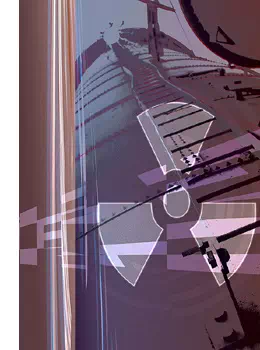 Radiological Materials in Veterinary Facilities Radiological Materials in Veterinary Facilities
Properties
Radiological materials are useful precisely because they are lethal. Rapidly dividing cells are generally more susceptible to radiation damage than non-dividing cells. This property makes radiological agents useful for cancer treatment.
Radioactivity results from reactions involving changes in atomic nuclei. A nuclear reaction typically results in the release of about a million times more energy per atom than a typical chemical reaction (which involves changes in the electron distribution around the nuclei, but leaves the nuclei themselves unchanged).
Radioactive substances are generally prepared by bombarding stable materials with high energy particles, transforming some of the nuclei into unstable states. To be useful as a therapeutic agent, the unstable nuclei must persist long enough to be administered to a patient and to act on the target tissue. The rate at which unstable nuclei emit radiation and decay into more stable states depends almost entirely on the composition of the material. The rate is expressed in terms of "half-life", the length of time needed for half of a given amount of the material to decay. Therapeutic materials are often chosen to have half-lives in the range of several days to several weeks. This allows enough time for transportation and storage of the material, but also allows the material to decay into a less hazardous form in a convenient period of time.
Two additional properties besides half-life are important for understanding the differences among various radioactive materials.
Particle type. When nuclei decay, they typically emit a low mass, fast moving particle. Most radioactive materials encountered in hospitals emit one of three types of particle, called (for historical reasons) alpha, beta, and gamma. The emitted particles differ in their ability to penetrate other materials.
- Alpha particles (helium nuclei) are strongly scattered by other nuclei, and thus have poor penetrating power. A few layers of cloth can stop alpha particles. The greatest danger from alpha emitters occurs when alpha-emitting material is inhaled or ingested.
- Beta particles (electrons) are intermediate.
- Gamma particles (high frequency packets of light energy, or photons) are less strongly scattered, and thus penetrate other materials effectively. Many feet of lead may be required to stop gamma particles.
Isotopes. Versions of a given element that differ by the number of neutrons they possess and thus also by their respective atomic weight.
Radioisotopes/Radionuclides. These are isotopes that emit ionizing radiation because of their unstable nuclei. Radioisotopes occur in nature and can be artificially produced.
Examples of radioisotopes used in veterinary medicine
- Iodine: 123I and 131I may be used in imaging (nuclear scintigraphy) of feline thyroid tissue. 131I is also one possible treatment for feline hyperthyroidism as well as feline thyroid adenomas.
- Technetium: Metastable technetium 99 (99mTc) in various forms is used in nuclear medicine imaging (scintigraphy).
Additional benefit of using a highly active, short-half-life isotope -- a little goes a long way -- can minimize quantity as well as storage time on site.

Compliance
Requirements
Licensing and other compliance issues related to the use of radioactive materials in veterinary medicine are discussed at NRC: Veterinary Uses of Nuclear Materials.
Disposal
of Radiological Wastes
Disposal of radiological waste is a complicated issue.
Decay on site may be an option for veterinary facilities licensed to utilize nuclear medicine. This process allows a licensed facility to store its radiological waste in a secure location within the facility until the material is safe for routine disposal into the appropriate waste stream. Since the radioisotopes used in veterinary medicine generally have half-lives of hours to days, decay on site is a practical option for some veterinary facilities if it is authorized in the NRC license.
Disposal of mixed waste (a combination of hazardous waste and radiologic waste) is regulated by both the EPA and the NRC.
More
Resources

|

